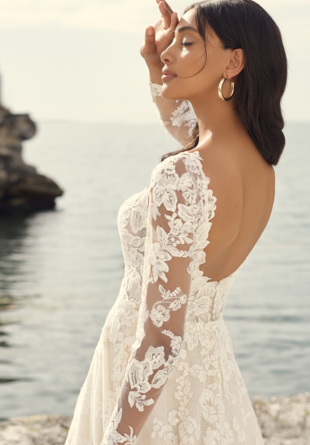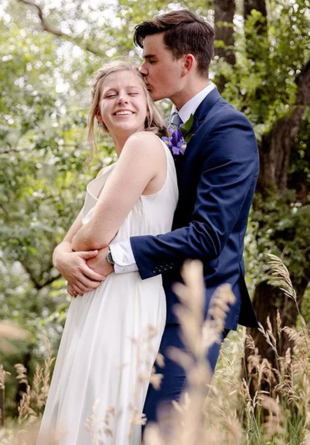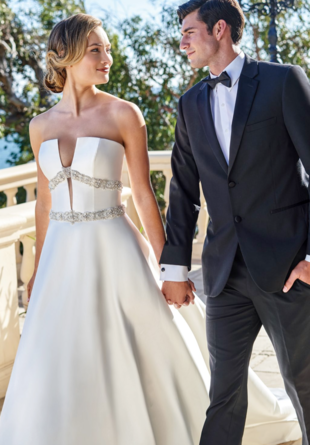Wondering When to Buy Your Wedding Dress? Bookmark This Shopping Timeline
I get it, there are a lot of steps in the wedding planning timeline and it's hard to keep everything straight. So if you find yourself confused about when to go wedding dress shopping, listen up. The thing is, when to buy your wedding dress isn't the same as when to start looking for a wedding dress. There are a lot of steps involved in wedding dress shopping, from budgeting for a wedding dress to researching fashion trends, booking appointments and even leaving time for wedding dress alterations.
Before you let all the steps overwhelm you, don't fret, this ultimate guide addresses the question that's been plaguing you: When should you go wedding dress shopping? Keep this timeline and these tips in mind as you start mapping out your schedule for when to wedding dress shop.
Everything to know about the wedding dress shopping timeline: When to Buy | Getting Started | 8–10 Months Out | 5–6 Months Out | 3–4 Months Out | 6–8 Weeks Out | 2–3 Weeks Out | 1 Week Out | Your Wedding Day | After the Wedding
When to Buy a Wedding Dress
Exactly when to shop for a wedding dress depends on the length of your engagement and how quickly you're getting hitched. According to The Knot Real Weddings Study, the average engagement length is 15 months. But those months will fly by—make sure you map out when you'll do your wedding dress shopping to ensure you don't suddenly find yourself behind.
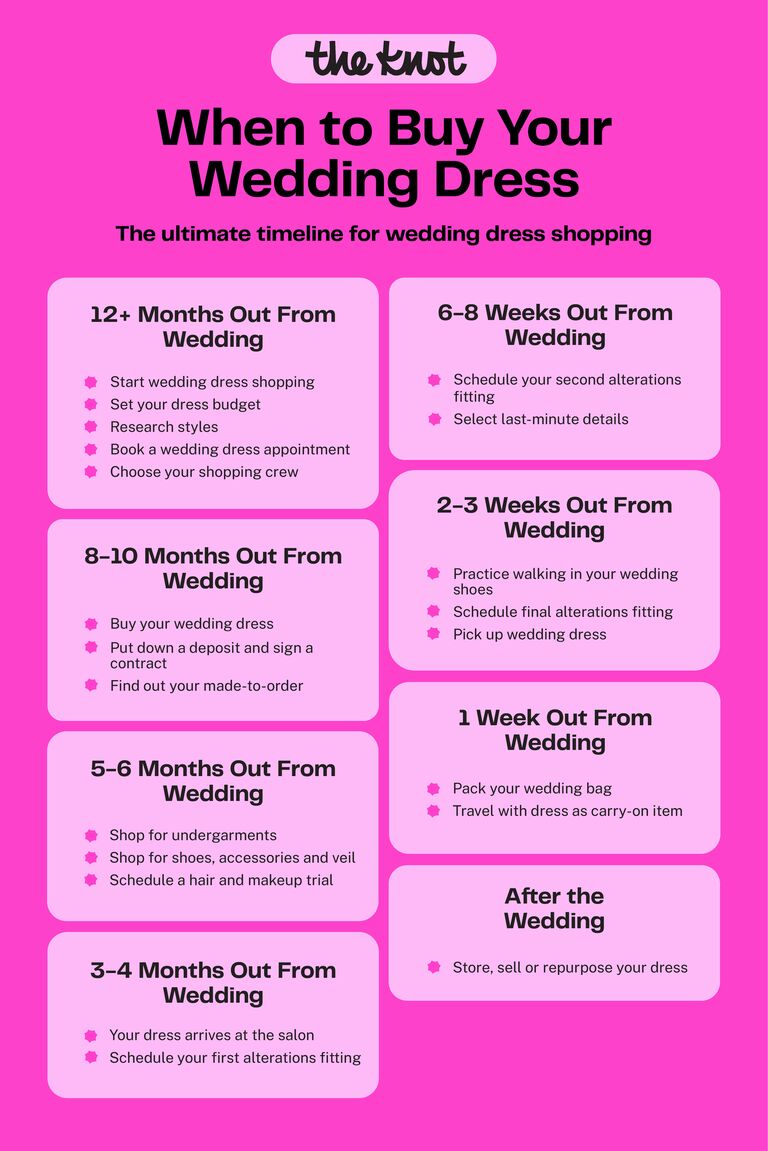
When should you go wedding dress shopping?
Ideally, you should start wedding dress shopping between nine months to a year before your wedding date. On average, in 2023 and 2024, brides started their wedding dress search 10 months out from their wedding, according to The Knot 2024 Attire & Fashion Study. In this survey we interviewed more than 800 folks married in 2023 and 2024 as well as nearlyweds who were either searching for wedding ceremony attire or had recently purchased their ceremony attire. At the 10-month mark those folks weren't necessarily visiting salons quite yet, but rather starting general research—we found that 46% of nearlyweds did most of their inspiration research online before actually buying a dress. And to get more specific, average respondents started visiting dress salons about 8.5 months out from their event and made the purchase 7.5 months out from the celebration. And while 55% of respondents bought dresses off the rack, it's especially important to start the process on the earlier side if you're interested in customizing your gown in any way.
If you don't find your dream wedding dress during your first shopping appointment, don't panic—it's completely normal to take a few appointments to find a gown that fits your vibe. According to our data, most to-be-weds visited 2 stores before making a selection. Everyone's experience is unique, so just keep in mind how long you think the process may take for you because dress production typically takes several months, which can mean limited options or rush order fees depending on how soon you're headed to the altar. Plan accordingly, and be sure to make your appointment at your local bridal salon ahead of time.
When should you buy your wedding dress?
Most survey respondents purchased their dresses 7.5 months before the wedding. As a rule of thumb, we recommend buying your wedding dress between 8 and 10 months before the wedding. Wedding dresses require time for production and shipping, meaning your dress could take up to five months (or sometimes even longer) to arrive. This leaves enough time for your wedding dress to be made to your measurements, shipped to the bridal salon, and sent to the tailor for alterations.
How long will it take to get my wedding dress?
Once you've found your dream wedding dress, you'll have to account for the dressmaking process. Making a wedding dress takes between four to six months on average, depending on the complexity of the design. Be sure to clarify with your wedding dress stylist if your chosen salon does in-house alterations. If not, see if they have a seamstress they can recommend, because you'll need anywhere from one to three alterations sessions before the wedding day to make sure your dress fits you perfectly.
Can you rush-order a wedding dress?
If you're having a short engagement because you just can't wait to marry your significant other or you just haven't had the time to shop, there are options. Many local wedding dress shops have off-the-rack dresses that can be purchased and taken home the same day. Sample sale gowns are also a fabulous option, along with ready-to-wear elopement looks and wedding dress rentals.
Want to shop quickly from the comfort of your couch? You can easily shop online for wedding dresses to cut down on time spent visiting salons. If you need alterations, the process can still be done in a time crunch, but be aware that there may be additional rush fees involved.
Getting Started
Here's a step-by-step look at everything you need to keep in mind to get started with buying a wedding dress.
1. Set your wedding dress budget
There's nothing worse than falling in love with a wedding dress that's simply outside your financial comfort zone. Shopping with a budget will ensure you only look at, and try on, dresses that work with your wedding budget. So, after setting your main wedding budget (which you can do with helpful insights from The Knot Budget Advisor), decide how much of that will be spent on your dress. Our data shows that wedding attire typically accounts for 7% of the overall budget, and in 2023, the average cost of a wedding dress was $2,000. You also want to budget for extras like taxes, alterations and shipping (or rush fees, in certain cases). And of course, don't forget to set aside a budget for accessories, like your wedding shoes, veil and jewelry.
2. Research wedding dress styles
Before you start wedding dress shopping, it's a good idea to figure out what you like (or what you want to completely avoid). And while you don't need to become a wedding dress expert overnight, knowing a few basics can help you describe your ideal dress when it's time to shop. Brush up on your inspiration board and look for common themes among the wedding dress necklines, fabrics and dress silhouettes you gravitate toward so you can easily share your ideal look with a stylist.
You can also use your overall wedding vibe as a starting point for narrowing down your dress options. If you're going for a beach wedding with neutral colors, consider a lighter fabric that can withstand the heat. Getting married at a grand castle wedding venue with regal decor? A fairytale-inspired ball gown may be the way to go.
While research is helpful, make sure you still keep an open mind. Doing your research can help narrow down your options at the start, but an experienced consultant can also help you find the right dress for your budget, body type and personal style.
3. Book a wedding dress appointment
Next up on your checklist: book a bridal appointment. According to our data, most to-be-weds try on 7 dresses before purchasing their chosen wedding dress. And where do they try those on? At wedding dress appointments.
The Knot Vendor Marketplace is filled with local wedding salons you can consider visiting. You can conveniently filter your search results based on your needs, with options ranging from online ordering to salons that offer group discounts and more.
We recommend starting with one to three dress appointments so you don't get overwhelmed by the shopping process. If you know you want to try a dress from a specific designer, see if they're having a trunk show (a traveling show of new and exclusive collections) at a salon near you.
4. Choose your shopping crew
After your appointments are locked, it's time to decide which loved ones and besties will be there to cheer you on as you try on dresses. Many to-be-weds choose to bring a small entourage of those who lift you up and support you. However, there are no rules about who you bring with you. Some nearlyweds even opt for shopping alone so they don't have to contend with outside opinions.
Hot tip: Be sure to check with the salon in advance to see if they have limits on the number of guests allowed in your party.
8–10 Months Before Your Wedding
Here are the wedding dress shopping plans to have in place for 8 to 10 months before the big day.
1. Buy your wedding dress
This is the moment—the sweet spot for when to buy your wedding dress. Ideally, during this time period, you'll say yes to the dress, and the salon can place your order.
2. Put down a deposit and sign a contract
When you purchase your gown, you'll be asked to sign a contract and put down a deposit. The deposit will vary by retailer, but it's often about 50% of the price of the dress, and the remaining balance will be due when you go to pick up your gown.
You will also sign a contract at this time. This will include all the details about your dress, including the designer, the size and when it will arrive. Before you sign your name on the dotted line, be sure to read through it thoroughly and double-check that all the information is correct. If it contains the wrong info and you sign it, the fault could be yours if you end up getting the wrong wedding dress (or the incorrect size or color). You'll also want to make sure any extras like alterations, veils, etc. are clearly listed and included in the final payment amount.
3. Find out your made-to-order timeline
Take this final opportunity to ask your stylist any questions you may have. Ask questions about how long it will take to order your wedding dress. On average, your dress will take 16 to 20 weeks from the day you place your order to arrive. So, you'll just want to confirm your wedding dress timeline because each store is a little different.

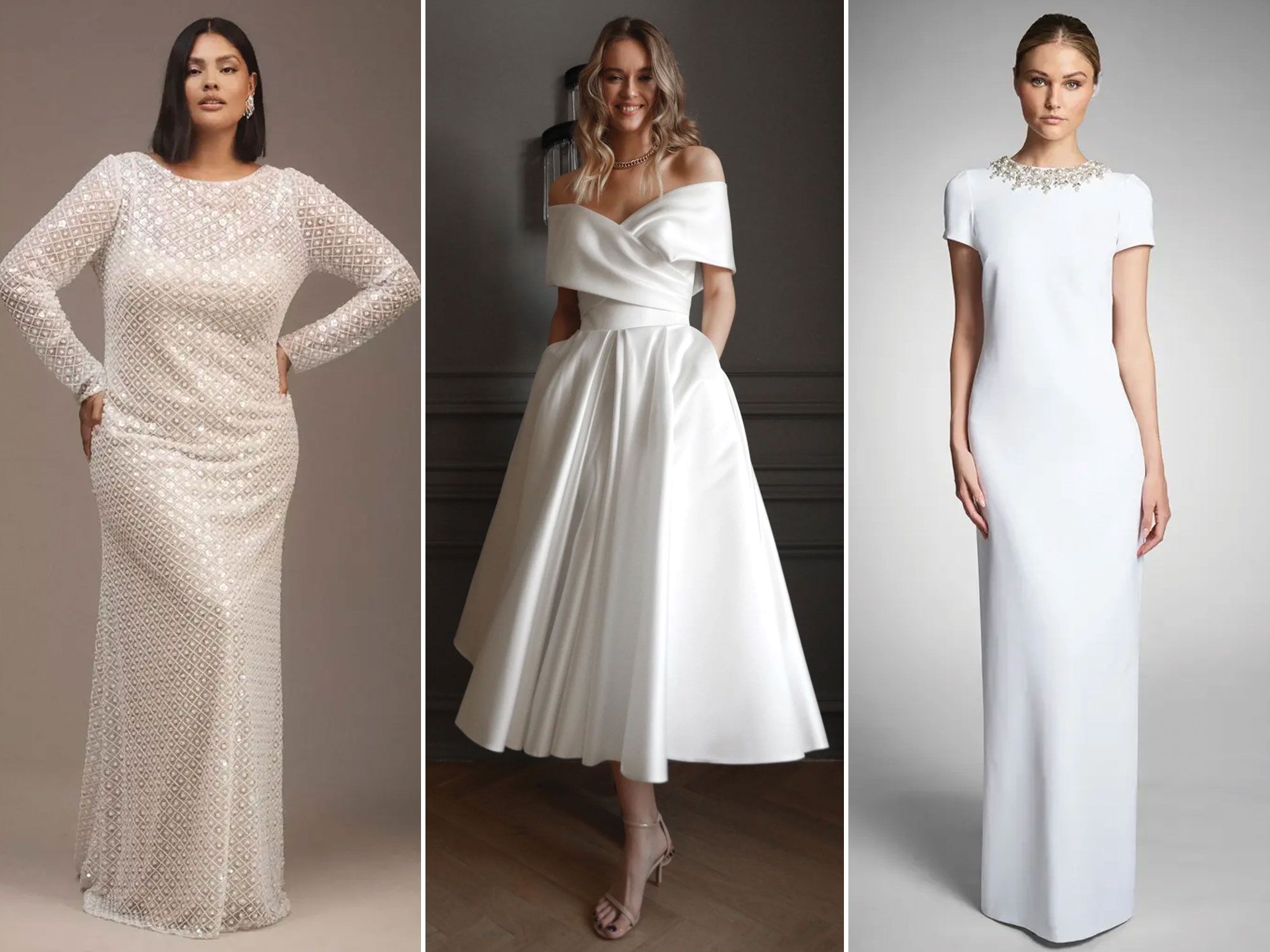
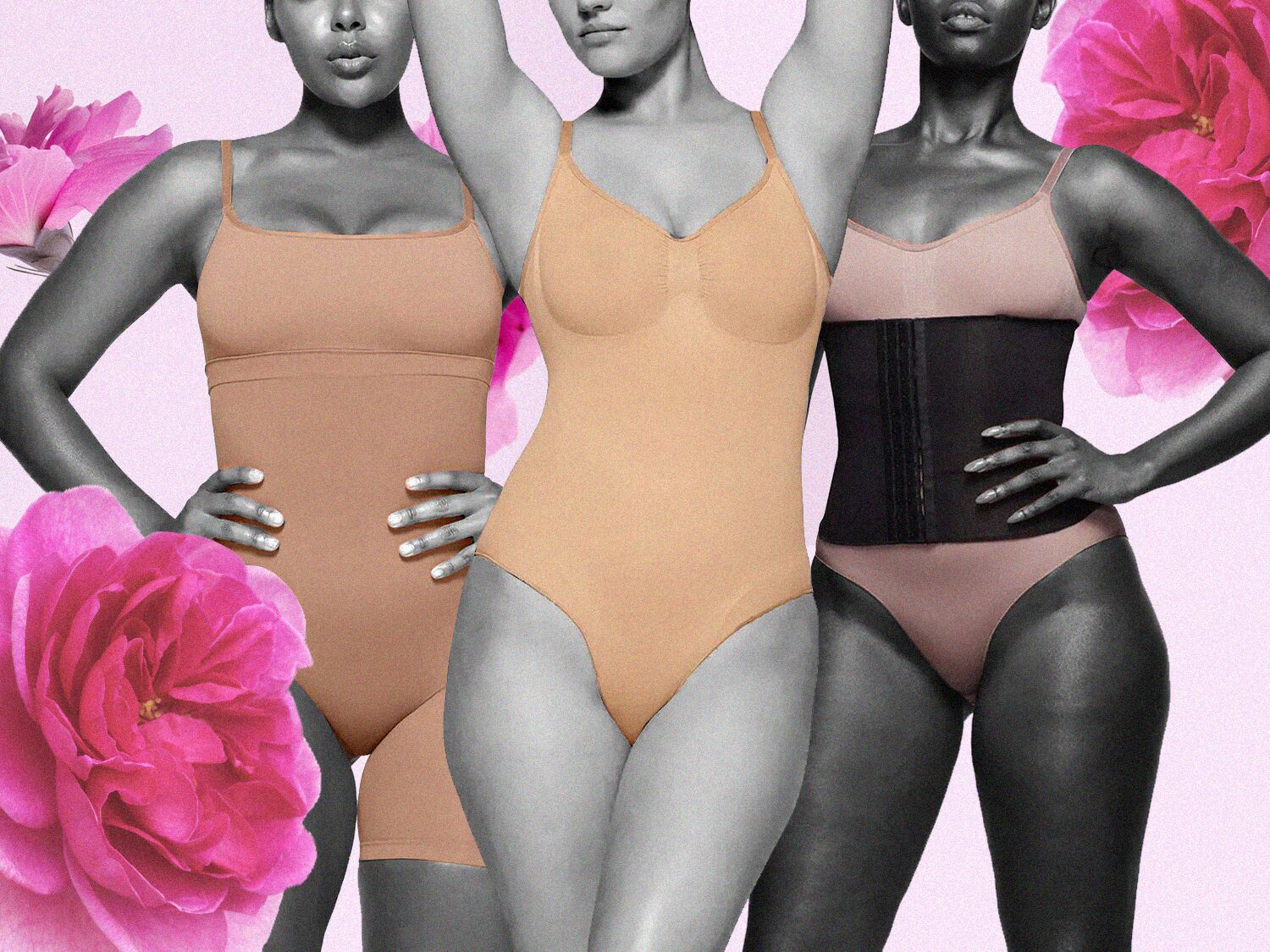
5–6 Months Before Your Wedding
While you're waiting on your wedding dress to arrive, there are some other fashion tasks to tackle. Here's what you should handle 5–6 months before your wedding.
1. Shop for wedding dress undergarments
If you haven't already, now is a great time to start shopping for your wedding undergarments, bridal shapewear and other intimate essentials. Why now? You need to bring exactly what you want to wear on your wedding day to your alterations fitting to ensure a flawless fit. So whether it's a strapless bra, nude undies or shapewear, having the proper undergarments on hand can make all the difference in how your dress looks and feels on the big day.
2. Choose your wedding shoes and accessories
While you're waiting for your dress to come in, treat yourself and shop for your wedding dress accessories like jewelry, shoes and even a clutch. Be sure to lock in your wedding accessories before your first fitting, especially your wedding shoes. The seamstress will need to know how to adjust the hem of your gown based on the height of your heels, or take the hem up even more if you're planning to wear flats or sneakers.
You don't need to wear a wedding veil on your wedding day if it's not your vibe (here are some veil alternatives!). However, if you are planning to wear one, aim to have it picked out by your first alterations appointment. This will give you (and your alterations specialist) a better idea of your entire look, from head to toe. For casual gowns, you can opt for a short blusher veil or a birdcage veil. If you're wearing a ball gown, bring the drama with something more grand, like a cathedral veil.
3. Schedule your wedding hair and makeup trial
Now that you know what you're wearing on the wedding day, you can start thinking about the rest of your look. Your hair and makeup trial should take place about five months before your wedding. Consider your wedding dress neckline and overall aesthetic to influence your hair and makeup. For example, if your gown has a show-stopping illusion lace back, consider showing it off with an updo.
3–4 Months Before Your Wedding
Your dress should be arriving around this time (insert happy dance!) Here's what to do next on your dress shopping checklist.
1. Your wedding dress arrives at the salon
It's finally here! Your wedding dress should arrive to the salon about three to four months before the wedding. Depending on the salon's policies, you'll be expected to pay the remaining balance on your dress when you pick it up. If you haven't already called up a professional seamstress for alterations, now is the time to do so as they can book up fast. Be sure to choose someone who has experience working on wedding dresses and formal wear. Pro tip: There are filters on The Knot Vendor Marketplace to show which dress salons offer alterations so you can conveniently find alterations near you.
2. Schedule your first alterations fitting
Now here's where the magic happens. Once the dress arrives from the designer, wedding dress fittings are the next phase of your wedding dress timeline. You'll generally have up to three alterations fittings to make sure that the dress fits like a glove, and it's important to get the timing of each appointment right. If your fittings are too far in advance, you may end up with a dress that doesn't fit properly—your body weight and shape could fluctuate after the gown is altered. On the other hand, waiting too long to schedule your alterations will leave you in a time crunch and may impact the cost of alterations if you encounter rush fees.
Your first alterations appointment is where the heavy lifting happens: adding sleeves, switching up the neckline, adjusting the hem or requesting customizations like beading. By the time you're done, you might slightly resemble a pincushion, but the finished product will be totally worth it. And don't forget to bring the undergarments and accessories you bought.
Most wedding gowns will need at least some form of alterations, even if it's just some small tweaks, and while some seamstresses charge a flat fee, others charge per service. The cost can range from $200 for a basic hem to more than $1,000 for major adjustments. To avoid sticker shock, ask for a quote or estimate before agreeing to the service.
6–8 Weeks Before Your Wedding
One-and-a-half to two months before the wedding is when you should be finalizing last-minute details. Here is exactly what you need to do with your wedding dress six to eight weeks before the wedding.
1. Schedule your second alterations fitting
Time for round two—The second fitting is your chance to make smaller tweaks to your wedding dress, like taking in the bodice or perfecting the hem length. During this fitting, you'll also want to make sure there's no obvious bunching or pulling anywhere on the dress. Move around the salon in your gown—sit down, stand up and practice some dance moves while you're at it. This will help you test that the fit is right and comfortable so you can easily get around (and breathe without feeling like you may split a seam). You'll be wearing your dress for 10 or 12 hours on your wedding day, so if something feels wrong, now is the time to speak up.
2. Select last-minute details
Now is the time to tackle personalization and heirloom details. If you want to include any special accents, like the "something old, something new" tradition) in your ensemble, it's a good idea to have them ready now. For example, if you're planning to sew a blue ribbon or other keepsake to the inside of your dress, you can ask your seamstress to do it while they're making the rest of the alterations.
2–3 Weeks Before Your Wedding
The big day is almost here. Here are the last-minute wedding dress details you aren't going to want to forget about when you're a few weeks away from the wedding.
1. Practice walking in your wedding shoes
As the saying goes, practice makes perfect. Whether you're wearing flats or four-inch heels on your wedding day, break in your wedding shoes at home to make sure they fit well.
2. Schedule your final alterations fitting
It's time for your final fitting. This is where you'll get to see your gown exactly the way it will look on your wedding day—cue all the tears. It's a good idea to bring at least one wedding VIP to the appointment so they can learn how to bustle the train or lace up the corset as needed.
3. Pick up your wedding dress
You've waited long enough; now is the time to pick up your wedding dress. Before you walk out the doors of the salon one final time, make sure everything looks just right. Check for snags, discolorations or other damage. If your veil is in the same bag, make sure it's stored in a protective pouch so it doesn't snag on any of the gown's embellishments.
Store your wedding dress in a breathable, opaque garment bag and keep it where your partner can't sneak a peek. A spare closet where the dress won't get squished is ideal, or store it at a wedding guest's home until the big day. If you have limited space, some salons will store gowns until just days before the wedding.
1 Week Before Your Wedding
It's the final countdown. Set aside some time this week to make sure you have the essentials and are ready for anything on the big day to ensure nothing slips through the cracks.
1. Pack your wedding day bag
A wedding day emergency kit is a must. Pack essentials like safety pins, fashion tape and a sewing kit to have on hand just in case. Also, make sure you have your entire wedding day outfit together. Your gown, veil, jewelry and shoes should all be ready to go in one place, especially if you're having someone help you transport everything to your venue on the wedding day.
Hot tip: Buy a handheld steamer (or if you already have one, make sure it's clean and works well) for your wedding day emergency kit to smooth out any last-minute wrinkles.
2. Traveling for your wedding? Carry your dress onboard
Hosting a destination wedding that requires air travel? Avoid checking your wedding dress and carry it on instead. If you check your dress, you risk potential damage, so it's best to never let it leave your sight. Confirm with your airline in advance that your garment bag will work as a carry-on (and make sure your garment bag is sturdy enough). Guess what? We have an entire guide on how to travel with your wedding dress, along with guidelines from several major airlines, to make prepping for your trip easy peasy.
Your Wedding Day
Happy wedding day! This is when all of your hard work and months of preparation finally pay off. Your entire vision has come together, and now you get to spend the day getting ready with your loved ones and finally putting on your dress. Enjoy and embrace every minute in your wedding dress.
After the Wedding
Your wedding day may be over, but the wedding dress decisions aren't. Now that you've had your best day ever in your dream dress. It's time to decide what you want to do with it— you can store, sell or even repurpose your dress.
Store, sell or repurpose your dress
If you're holding onto the dress as a memento, you'll want to take care of it as best you can. Storing your beloved gown isn't as simple as hanging it up in the closet with the rest of your clothes, as it can lead to damage and discoloration over time. Luckily, there are plenty of ways to preserve your wedding dress. One option is Wedding Dress Preservation by The Knot, our very own service that cleans and stores your gown safely in a keepsake box. Another trusted option includes Unbox the Dress, a service that re-designs your gown into a new style you can wear every day. If you'd rather see your beautiful wedding dress make someone else's wedding dreams come true, you can opt to donate or sell your wedding dress instead.
Additional reporting by Lauren Whalley


